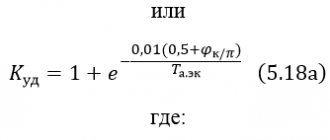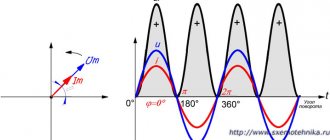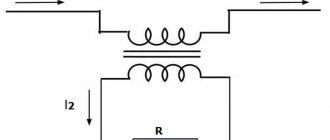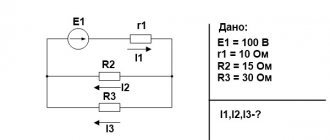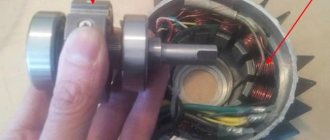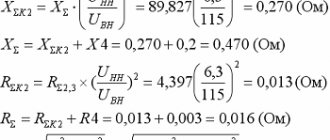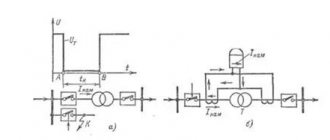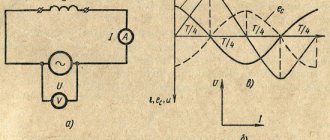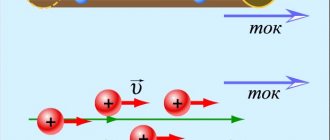Aperiodic component of short circuit current
When a short circuit occurs, the constant current values undergo significant changes. At the very first instant, the so-called aperiodic component of the short-circuit current appears, which quickly fades away and takes on a zero value. This time interval when these changes are observed represents a transition period, defined in numerical terms. Until the emergency current condition is turned off, the electrical network operates in a steady-state short circuit mode.
- Physical properties of the aperiodic component
- Total current when a short circuit occurs
- How to calculate the aperiodic component
- Features of calculations in multi-loop circuits
Physical properties of the aperiodic component
A similar current state occurs at the moment of a short circuit. Its duration and characteristics may vary, depending on many factors. For example, if the motor has a damper winding, the aperiodic component of the short circuit current will be lower than if it is absent. First, a supertransient current arises, which at first becomes simply transient, and only then does it begin to fade.
During a two-phase circuit, sudden changes in current do not appear in the stator. In such situations, at idle, an aperiodic component appears, the parameters of which coincide with the initial value of the variable component. Since the short-circuit current inside the stator is single-phase, in some cases the appearance of an aperiodic component is completely eliminated. In asynchronous motors, this indicator is not taken into account, since these processes die out very quickly. It is not taken into account even when calculating short-circuit surge currents.
In general, the magnitude of these components will differ for each phase. Its initial parameters will depend on the moment the short circuit appears. On the graphs it represents a solid curved line, since all the initial amplitudes of the other components will be equal to it, but directed in the opposite direction.
The presence of an aperiodic component is established when the contacts diverge. To evaluate it, there is a special parameter, which is the relationship between it and the periodic amplitude at the moment the contacts open. The decay time is approximately 0.1-0.2 s and is accompanied by significant heat generation. Under the influence of high temperatures, current-carrying parts and the entire equipment as a whole heat up noticeably, despite such a short period of time.
Total current when a short circuit occurs
The aperiodic component itself cannot be considered, since it is one of the components of the short circuit current. The electrical network contains inductive resistances that prevent the current from changing instantly at the moment a short circuit occurs. The increase in load current does not occur spasmodically, but according to certain laws that require a transition period from normal to emergency values. Calculation and analytical work is greatly simplified when the short-circuit current during a transition is considered as two components - aperiodic and periodic.
The aperiodic part is a component of the current ia with a constant value. It appears immediately at the moment of short circuit and in the shortest possible time drops to zero.
The periodic part of the short-circuit current Iпm is called the initial part, since in time it appears at the very beginning of the process. This indicator is used to select the most suitable setting or check the sensitivity of relay protection. This current is also known as subtransient current, since it is determined using subtransient resistances introduced into the equivalent circuit. The periodic current is considered to be steady when the aperiodic part fades and the transient process itself ends.
Consequently, the total short circuit current will be the sum of both parts - aperiodic and periodic during the entire period of state transition. At a certain moment, the total current reaches its maximum value in the shortest possible time. This condition is known as short-circuit shock current, which is determined when checking the electrodynamic stability of installations and equipment.
The choice of initial or supertransient current for calculations determines the rapid decay of the aperiodic part, which occurs before the protection is triggered. In this case, the periodic component remains unchanged.
Electrical networks connected to generator sets or a power-limited power system are characterized by significant voltage changes when a fault occurs. In this regard, the currents, initial and steady, will not be equal to each other. In order to calculate relay protection, you can use the initial current indicators. In this case, the error will be insignificant in comparison with the steady-state current exposed to various factors. First of all, this is increased resistance at the damaged point, load currents and other parameters that are most often not taken into account when performing calculations.
How to calculate the aperiodic component
The initial value of the aperiodic part in modular terms is defined as the difference between the instantaneous indicator of the periodic part at the beginning of the short circuit and the current value immediately before the short circuit. That is, the aperiodic component with the maximum initial value will be equal to the amplitude parameters of the periodic part of the current when a short circuit occurs. This statement is determined by the formula: ia0 = √2Iп0, operating under the condition of a reduced active fraction of the resistance at the short-circuit point relative to the inductive component.
1.
2.
In addition, before the start of the circuit there should be no load at the design point, and the voltage of any phase by this time passes through the neutral conductor. If the listed requirements are not met, then the aperiodic part in the initial stage will reduce its performance in relation to the amplitude of the periodic component.
In order to calculate the aperiodic component of the short-circuit current at any arbitrary time, a substitution option is worked out in advance. According to the initial design scheme, all components are taken into account as active and inductive reactances. Accounting for synchronous generators and compensators, asynchronous and synchronous electric motors is carried out by transferring them to the category of inductive reactances with negative sequence. The resistance of the stator windings to direct current with the operating temperature of the established norm must be taken into account.
3.
When the initial calculation scheme contains only components connected in series, in this case the value of the aperiodic fraction at any time is determined by formula 1, in which Ta is a constant value that determines the decay time of this part. In turn, Ta can be calculated using formula 2, in which Xek and Rek will be the inductive and active components, and ωsync is the synchronous angular frequency of the mains voltage. If, in the calculations, it is necessary to take into account the value of the generator current immediately before the short circuit, then formula 3 is already used.
What is phase-to-phase fault?
This is an emergency mode of operation of the electrical network caused by electrical contact of opposite phases. As an example, we give typical types of closures.
Types of short circuits
Designations:
- Three-phase short circuit.
- Short circuit of two phase wires.
- Short circuit to ground during a two-phase fault.
- Phase (single-phase) short circuit. A short circuit can occur to ground or the neutral wire in systems with an insulated or grounded neutral.
As can be seen from the figure, point 2 fits the definition of a phase-to-phase short circuit. Note that, under certain conditions, 1 and 3 can also be considered as a special case of a phase-to-phase short circuit.
Features of calculations in multi-loop circuits
If multi-loop circuits are used in the calculations, then the exponential law of time change does not affect the aperiodic component. In fact, it appears as a sum of currents, each of which is an exponential time function and decays at different time intervals. The number of such components in circuits with active and inductive branches coincides with the number of independent circuits.
In this case, aperiodic components can be calculated using special systems of differential equations that take into account all active and inductive resistances. The calculation method largely depends on what the initial calculation diagram looks like and where the calculated short circuit location is located.
In some embodiments, the energy sources of a multi-circuit circuit are closed to the calculated short-circuit location using a common resistance. Approximate calculations make it possible to establish the attenuation of the aperiodic component over a certain constant period of time. There are two solution methods that, with respect to the exact result, produce an error with a positive or negative direction. That is, the time constant will be overestimated or underestimated.
The design circuit, divided by the short circuit point into parts independent of each other, at an arbitrary point in time is determined as the sum of aperiodic components provided for each section of the circuit. Their change over time occurs relative to a constant indicator, and the data obtained are taken into account in the calculations.
Short circuit surge current
Short circuit current of single-phase and three-phase networks
Source
Short circuit in a circuit powered by constant voltage buses
Figure 1 shows a simple symmetrical three-phase circuit with active inductive reactance, which is typical for most real electrical networks. The circuit is powered from a source that, in normal operation and during a short circuit, maintains a symmetrical and unchanged three-phase voltage system at the terminals. The vector diagram of the circuit under consideration for normal operation is shown in Fig. 2, a. The angle φ between the current and voltage of each phase is determined by the ratio of the active and inductive reactances of the entire circuit, including the load.
Fig.1. Three-phase symmetrical circuit powered from constant voltage busbars (from an infinite power source)
Fig.2. Vector diagrams of currents and voltages: a - in normal mode; b - with a three-phase short circuit
A short circuit divides the circuit into two parts: the right with resistances r1 and x1 = ωL1 in each phase and the left, containing the power source and short-circuit resistances rK and xK = ωLK. Processes in both parts of the circuit during a three-phase short circuit proceed independently.
The right side of the circuit under consideration turns out to be shunted by a short circuit, and the current in it will be maintained only until the magnetic field energy stored in inductance L1 is converted into heat released in the active resistance r1. This current, with the active-inductive nature of the circuit resistance, does not exceed the normal mode current and, gradually attenuating to zero, does not pose a danger to the equipment.
A change in mode on the left side of the circuit containing the power source, in the presence of inductance LK, is also accompanied by a transient process. From the course “Theoretical Foundations of Electrical Engineering” we know the equation that describes this process:
(1)
where u and i are the instantaneous values of voltage and current of the phase under consideration, respectively.
Solving this equation gives an expression for the instantaneous value of the current at any time t from the beginning of the fault:
(2)
where Um is the amplitude value of the phase voltage of the source; ZK is the total resistance of the circuit section connected to the source (short-circuit circuit); α is the phase angle of the source voltage at the moment t = 0; φK is the shift angle of the current in the short-circuit circuit relative to the source voltage of the same phase; Ta is the time constant of the short-circuit circuit:
(3)
As can be seen from (2), the total short-circuit current consists of two components: forced, due to the action of the source voltage (the first term on the right side of the equation), and free, due to the change in the magnetic field energy reserve in the inductance LK (the second term of the equation).
The forced component of the short-circuit current is periodic in nature with a frequency equal to the frequency of the source voltage. This component is usually called the periodic component of the short-circuit current
(4)
where Iп,m is the amplitude value of the periodic component of the current.
The shift angle φK between the current and voltage vectors is determined by the ratio of the active and inductive resistances of the short-circuit circuit. For real circuits, usually xK » rK and φK = 45-90°. The vector diagram for the periodic component of the short circuit at φK = 90° is shown in Fig. 2b. Free current component
(5)
has an aperiodic nature of change, on the basis of which this current component is also called the aperiodic component of the short-circuit current.
The initial value of the aperiodic component of the short-circuit current in each phase is determined by expression (2) for time t=0:
(6)
here iK,0 is the initial value of the short-circuit current, which, taking into account the impossibility of changing the current abruptly in a circuit with inductance, is equal to i(0) - the current of the previous mode in a given phase at the moment t=0. The value of the periodic component of the current at t=0 is determined as
(7)
Of particular interest are the conditions for the occurrence of the maximum possible value of the total short-circuit current and its aperiodic component. From (6) and (7) with xK » rK and φK≈90° it follows that the maximum current value ia,0 will be if the voltage at the moment of the short circuit passes through the zero value (α=0) and the current in the circuit is up to There is no short circuit, i.e. i(0)=0. In this case, ia,0=Iп,m. The current change curve under the condition of the maximum value of the aperiodic current component is shown in Fig. 4. Here ia,0=Iп,m.
Fig.3. Change in short-circuit current in a circuit fed from constant voltage buses at the maximum value of the aperiodic component
The maximum instantaneous value of the total current usually occurs 0.01 s after the start of the short-circuit process (Fig. 3). It is called shock current and is designated iy. The shock current will be determined from (2) for the moment t=0.01s:
(8)
or
(9)
where ky is the shock coefficient depending on the time constant of the short-circuit circuit:
(10)
The transient process in the case of power supply from constant voltage buses ends after the aperiodic component of the current has attenuated, and then the total short-circuit current is equal to its periodic component, unchanged in amplitude.
The effective value of the current for an arbitrary short circuit time t is equal to:
periodic component
(11)
aperiodic component
(12)
full short circuit current
(13)
Periodic component - current
The periodic component of the current varies along a harmonic curve in accordance with the sinusoidal EMF of the generator. Aperiodic - determined by the nature of the attenuation of the short circuit current, which depends on the active resistance of the circuit and the stator windings of the generator. [1]
The periodic component of the current / r in branch G changes over time in accordance with the parameters of the generators (compensators), the characteristics of the excitation regulators, the distance of the closure point, etc. The periodic component of the current 1pC of branch C is constant over time. [2]
The periodic component of the current varies along a harmonic curve in accordance with the sinusoidal EMF of the generator. Aperiodic - determined by the nature of the attenuation of the short circuit current, which depends on the active resistance of the circuit and the stator windings of the generator. [4]
The periodic component of the current / n ( r in branch G changes in time according to a complex law determined by the parameters of the generators and the characteristics of the excitation regulators. The periodic component of the current / n s in branch C is assumed to be undamped. The periodic component of the current at the fault point is equal to the sum of these two currents. Two-beam the circuit is used to determine the quadratic current pulse at k. [6]
The periodic component of the short-circuit current from the generator varies over time according to a complex law. [7]
The periodic component of the stator current under normal switching conditions should not exceed 3–5 times the rated current. In emergency operating modes, the periodic component is allowed to be five times greater than the rated current. [8]
The periodic component of the stator current during normal switching on of the generator should not exceed more than 3-5 times the rated current. In emergency operating modes, the periodic component is allowed to be five times greater than the rated current. [9]
The periodic component of the stator current (simultaneously with all odd harmonics) decreases to its steady value with the time constant of the rotor circuit. The aperiodic component of the rotor current, which occurs during a sudden short circuit, decreases according to the same law to a steady-state value of direct current IrL. In the rotor circuit, all even higher harmonics are detected in steady state. [10]
The periodic component of the short-circuit current at the initial moment of time / n is called the initial short-circuit current. The value of the initial short-circuit current is used, as a rule, to select settings and check the sensitivity of relay protection. [12]
The periodic component of the stator current during normal switching on of the generator should not exceed more than 3-5 times the rated current. In emergency operating modes, five times the periodic component is allowed in relation to the rated current. [13]
When there is a short circuit behind the reactor, the periodic component of the short circuit current does not change with time ( / 7), which makes it possible to accept t tpac4 22 sec. [14]
Phase-to-phase short circuit: methods of protection and prevention, places of occurrence
When operating high-voltage electrical circuits, a phenomenon often defined by regulatory documents as an interphase short circuit occurs. This deviation from the normal operation of power supply systems is associated with faults in the supply lines, the consequences of which can be unpredictable. The particularly dangerous nature of possible damage forces us to deal with a number of questions regarding what this phenomenon is, what troubles it leads to and how to avoid them.
Concept and reasons for closures
The cause of a short circuit, as a rule, is a violation of the wire insulation
An interphase electrical short circuit in multiphase circuits is the unintentional connection of insulated conductors with damaged protective coating.
In some cases, it manifests itself as a single-phase fault to the ground or the body of operating electrical equipment.
This state of the electrical network is a violation of the normal operating mode of the system and is interpreted as an emergency. In this case, at the points where two conductors short circuit or at the points of their contact with the ground, the current increases significantly. Its maximum value sometimes reaches several thousand Amperes. Uncontrolled flows of electricity can lead to devastating consequences.
The causes of emergencies in high-voltage electrical networks are:
- Damage to the protective insulation of each phase conductor due to violations of the operating rules of cable lines.
- Accidental break of one of the cores of an overhead cable and its short circuit to another wire or ground.
- Short circuit of a wire with damaged insulation to the body of an operating electrical installation.
Each case of a short circuit is a consequence of a gross violation of the rules for operating electrical equipment and, in accordance with the requirements of regulatory documents, requires a thorough investigation.
Types of emergency circuits
According to the type of power supply, all short circuits are divided into damage that occurred in single-phase or three-phase circuits, and according to their number - into single and double short circuits. The simplest case is single-phase lines, in which only a single phase to neutral or ground is possible. A three-phase short circuit has a greater range of possibilities, since the number of wires in the cable increases to 3. The following types of damage are possible:
- Shorting two high-voltage wires together.
- Short circuit of one wire to neutral or ground (single-phase short circuits).
- Contact of two conductors with the ground surface at once.
